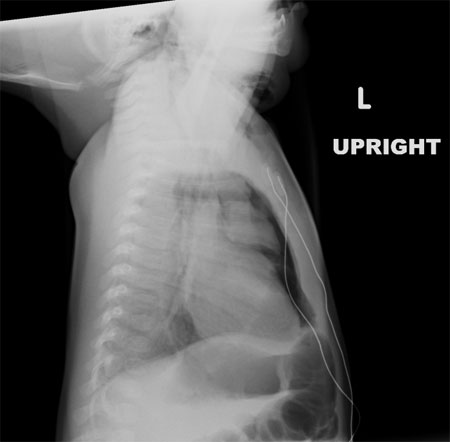A two-month-old, previously healthy infant that was born at term presents to the ED with increasing respiratory distress. There are decreased breath sounds bilaterally and the infant is drooling and gagging on secretions. The chest radiographs are shown below.


Accessible Version
Frontal and lateral chest radiographs of an infant with large bilateral evidence of air in the pleural spaces.
After stabilization of the patient, an appropriate next step in the evaluation includes which of the following:
◯
A. Evaluate for cystic fibrosis.
◯
B. Evaluate for upper airway injury.
◯
C. Evaluate for congenital diaphragmatic hernia.
◯
D. Review the birth history for meconium aspiration.
After stabilization of the patient, an appropriate next step in the evaluation includes which of the following:
◯
A. Evaluate for cystic fibrosis.
✓
B. Evaluate for upper airway injury.
◯
C. Evaluate for congenital diaphragmatic hernia.
◯
D. Review the birth history for meconium aspiration.
The best answer is B
The patient presented in respiratory distress and has bilateral pneumothoraces. This is an unusual presentation for an infant. Neck, chest, tracheal and esophageal trauma should be suspected immediately. A history of potential trauma should be obtained as part of the evaluation. Although these injuries are more common in adolescents or adults, blunt trauma to the neck or chest, motor vehicle accidents, gunshot wounds or stabbing may present similarly. Upper airway injury from forced oral penetration of an object should be considered in an infant with injuries to the oral cavity, hypopharynx, neck, trachea or esophagus.
Direct laryngoscopy of this patient revealed an esophageal tear. The patient should be evaluated further for non-accidental trauma and an evaluation for sexual abuse considered. In addition, the case should be reported to child protective services.
Pharyngeal or cervical esophageal perforations occur commonly at the site of the hypopharyngeal-esophageal junction. This area is anatomically weak and likely to be injured with instrumentation or forced oral penetration. In addition to drooling, respiratory distress and the pneumothoraces as seen in this case, the injury may result in subcutaneous emphysema of the neck, pneumomediastinum, fever, dysphagia and abnormal cry. Rib fractures may be present and suggest chest compression. Future complications may occur including esophageal abscess, esophageal stricture and/or sepsis.
Bilateral pneumothoraces with underlying cystic fibrosis has been reported as early as the newborn period and is associated with a poor prognosis. This is an unusual finding as well as a life threatening complication of cystic fibrosis, but a work up for this is not the appropriate next step in the evaluation.
Congenital diaphragmatic hernia may present with a pneumothorax. This chest radiograph does not demonstrate a diaphragmatic hernia. These hernias are described as failure of closure of the diaphragm during development. There may be herniated abdominal contents in the chest and the finding of pulmonary hypoplasia.
Meconium aspiration syndrome presents shortly after birth in a newborn with respiratory distress and a history of meconium aspiration. Bilateral pneumothoraces or unilateral pneumothoraces may occur as part of this process. However, this patient was previously well until 2 months of age. Respiratory problems from neonatal meconium aspiration should have occurred immediately post partum and delayed respiratory distress has not been reported.
Other possible causes of bilateral pneumothoraces include inhalation of vapors, such as from mercury, cocaine, nail polish or other toxins. Therefore, a urine toxicology screen is recommended.


